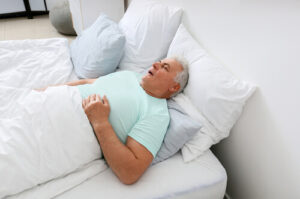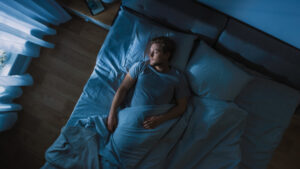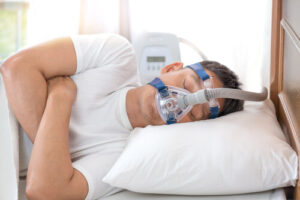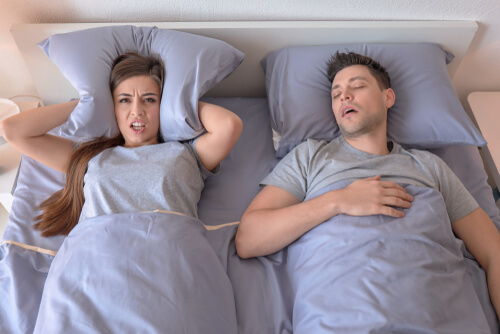In the vast realm of sleep disorders, the telltale signs of sleep apnea often echo in loud, disruptive snores. However, a subtler, less recognized variant lurks beneath the surface — sleep apnea without snoring. While snoring often serves as an audible alarm for potential sleep issues, many are unaware that sleep apnea can manifest silently, making it a silent threat to restful nights and overall health. Let’s dive deeper into this less-talked-about facet of sleep apnea and shed light on its implications.
Overview of sleep apnea
Sleep apnea is a prevalent sleep disorder characterized by repeated interruptions in breathing during sleep. These interruptions can last seconds to minutes and may occur 30 or more times an hour. Typically, normal breathing starts again, sometimes with a loud snort or choking sound. While many associate sleep apnea with the hallmark sign of loud, chronic snoring, it’s a misconception that it’s always present. Many individuals are taken aback to discover they have sleep apnea without the accompaniment of disruptive snores. This mistaken belief can lead to undiagnosed and untreated cases, posing significant health risks to those unaware of the silent nature of their condition.
The Mechanism Behind the Silence
Obstructive Sleep Apnea (OSA) and Central Sleep Apnea are both types of sleep apnea, but they have different causes and characteristics. Here’s a distinction between the two:
Obstructive Sleep Apnea (OSA):
- Cause: OSA is caused by a physical blockage in the airway, typically when the soft tissue at the back of the throat collapses and closes during sleep. This blockage prevents airflow despite the effort to breathe.
- Symptoms: This is what others refer to as ‘snoring’ sleep apnea. It’s often associated with loud snoring, though not everyone with OSA snores. Other symptoms can include choking or gasping for air during sleep, frequent awakenings, daytime sleepiness, and fatigue.
- Prevalence: OSA is the most common form of sleep apnea.
- Risk Factors: Factors increasing the risk of OSA include obesity, a narrowed airway, recessed chin, thick neck circumference, being male, family history, use of alcohol or sedatives, smoking, and congestion from medical conditions like allergies or facial bone structure.
- Treatment: Common treatments for OSA include lifestyle changes (like weight loss or position-based strategies), Continuous Positive Airway Pressure (CPAP) devices, dental appliances, and surgery in more severe cases.
Central Sleep Apnea:
 Cause: Central sleep apnea is less common and occurs when the brain fails to transmit the appropriate signals to the muscles responsible for breathing. There’s no physical blockage, but the brain momentarily “forgets” to instruct the body to breathe.
Cause: Central sleep apnea is less common and occurs when the brain fails to transmit the appropriate signals to the muscles responsible for breathing. There’s no physical blockage, but the brain momentarily “forgets” to instruct the body to breathe.- Symptoms: Snoring can be less prevalent in central sleep apnea. Other symptoms include abrupt awakenings accompanied by shortness of breath, difficulty staying asleep, and chronic fatigue during the day.
- Prevalence: Central Sleep Apnea is less common than OSA.
- Risk Factors: It can be associated with conditions like heart failure, stroke, and medications like opioids. It can also develop in individuals without apparent reasons, known as idiopathic central sleep apnea.
- Treatment: Treatment might involve addressing associated medical problems, optimizing heart failure therapy, reducing contributing medications, and using devices such as adaptive servo-ventilation or bilevel-positive airway pressure.
Symptoms to Watch Out For
When considering sleep apnea, especially when snoring isn’t evident, it’s crucial to recognize its various other associated symptoms. Identifying these symptoms early on can lead to a more timely diagnosis and treatment. Here are the symptoms to watch out for:
- Daytime Sleepiness: Snoring cannot be the most common symptom since CSA wouldn’t cause a patient to snore. Therefore, individuals with sleep apnea often feel unusually tired or sleepy during the day despite having had a full night’s sleep.
- Choking or Gasping: Episodes where the individual suddenly wakes up gasping for air or choking, often due to the body’s reflex to restart breathing.
- Frequent Awakenings: Waking up multiple times during the night, often so briefly that they don’t remember it the next morning.
- Morning Headaches: Regularly waking up with a headache, which can be due to low oxygen or high carbon dioxide levels during sleep.
- Dry Mouth or Sore Throat upon Waking: This can occur because of breathing through the mouth during sleep.
- Night Sweats: Experiencing excessive sweating during the night is not linked to an overheated environment.
- Difficulty Concentrating: Struggling with focus, memory, and cognitive tasks due to disrupted sleep.
- Mood Changes: Experiencing irritability, depression, or mood swings, often resulting from sleep deprivation.
- Decreased Libido: A reduction in sexual desire can be linked to hormonal changes due to sleep disruption.
- High Blood Pressure: Sleep apnea can lead to or exacerbate hypertension due to the strain of low oxygen levels at night.
- Restless Sleep: Tossing and turning or having difficulty maintaining a comfortable sleep position.
- Difficulty Staying Asleep: Also known as insomnia, some individuals might fall asleep easily but find themselves waking up frequently or for extended periods.
Remember, these symptoms can indicate sleep apnea but can also be associated with other conditions or lifestyle factors. If someone suspects they have sleep apnea, especially if they’re experiencing multiple symptoms from this list, it’s essential to consult a healthcare professional for an accurate diagnosis.
Risk Factors and Underlying Causes
Sleep apnea can affect anyone, regardless of age or gender. However, certain factors increase the likelihood of developing this condition. Here are the risk factors associated with sleep apnea:
 Excess Weight: Obesity greatly increases the risk of sleep apnea. Fat deposits around the upper airway may obstruct breathing.
Excess Weight: Obesity greatly increases the risk of sleep apnea. Fat deposits around the upper airway may obstruct breathing.- Neck Circumference: Those with a thicker neck might have a narrower airway, increasing the risk of blocked airflow.
- A Narrowed Airway: This may be a hereditary condition. Enlarged tonsils or adenoids can also block the airway, especially in children.
- Being Male: Men are two to three times more likely to have sleep apnea than women. However, the risk for women increases if they’re overweight, and it also seems to rise after menopause.
- Age: Sleep apnea is significantly more common in older adults.
- Family History: Having family members with sleep apnea might increase your risk.
- Use of Alcohol or Sedatives: These substances relax the muscles of your throat, increasing the risk of airway obstruction.
- Smoking: Smokers are likelier to develop sleep apnea than those who’ve never smoked. Smoking can increase inflammation and fluid retention in the airway.
- Nasal Congestion: If you struggle to breathe through your nose due to an anatomical problem or allergies, you’re more likely to develop obstructive sleep apnea.
- Cardiac Problems: Congestive heart failure is associated with an increased risk of central sleep apnea. Also, atrial fibrillation is a common condition in people with sleep apnea.
- Stroke or Brain Tumor: These conditions can lead to central sleep apnea.
- Polycystic Ovary Syndrome, Prior Polio, and Hormonal Disorders: These conditions can also increase the risk of obstructive sleep apnea. Also, individuals with an underactive thyroid (hypothyroidism) or an abnormal growth hormone level might experience sleep apnea.
- Diabetes: A noted increased risk of obstructive sleep apnea among people with type 2 diabetes.
- A History of Sleep Deprivation: Chronic sleep deprivation can lead to an increased risk of sleep apnea.
- Pregnancy: Some women may develop sleep apnea during pregnancy due to weight gain and hormonal changes.
- Prior History: Those with a history of sleep apnea or surgeries involving the upper airway might be at increased risk.
While having one or more of these risk factors doesn’t mean someone will develop sleep apnea, they elevate the chances. Regular monitoring and early intervention can help manage potential complications and improve sleep quality and health.
Diagnosis and Treatment Options
Diagnosing and treating sleep apnea is crucial to prevent complications and enhance the quality of life for those affected. Here’s a rundown on the common methods for diagnosis and the various treatment options available:
Diagnosis:
- Physical Examination: This includes checking the mouth, nose, and throat for enlarged tissues, like tonsils, uvula, or soft palate. Neck circumference and body mass index (BMI) may also be checked.
- Polysomnography: Often referred to as a sleep study, polysomnography is the most definitive test for sleep apnea. It involves monitoring numerous body functions during sleep, including brain electrical activity, eye movement, muscle activity, heart rate, respiratory effort, airflow, and blood oxygen levels.
- Home Sleep Apnea Testing: Doctors may sometimes provide portable equipment to monitor sleep at home. These tests usually measure heart rate, airflow, and oxygen levels.
Treatment Options:
Lifestyle Changes:
- Weight loss: For overweight people, losing weight can significantly reduce or even eliminate apnea episodes. This can also help your snooze and breathing even if you have undiagnosed sleep apnea.
- Positional therapy: Some people experience sleep apnea primarily when sleeping on their back. Sleeping on the side cannot treat sleep apnea but can help in such cases.
- Avoiding alcohol and sedatives: These can relax the throat muscles and worsen sleep apnea.
- Smoking cessation: Quitting smoking can alleviate symptoms.
- Nasal decongestants or allergy treatments: These can help if nasal congestion contributes to the problem.
 Continuous Positive Airway Pressure (CPAP):
Continuous Positive Airway Pressure (CPAP):
This is the most commonly prescribed treatment for moderate to severe sleep apnea. A CPAP machine delivers air pressure (via a mask) that’s somewhat greater than the surrounding air, regulating your breathing patterns and keeping the upper airway passages open.
Bilevel Positive Airway Pressure (BiPAP or BPAP):
This device provides more air pressure when inhaling and less when exhaling and can be an alternative for people who have difficulty adapting to a CPAP to control breathing.
Adaptive Servo-Ventilation (ASV):
This device can benefit those with central sleep apnea and some with complex sleep apnea. It stores information on the person’s normal breathing pattern and automatically uses airflow to prevent pauses in breathing.
Dental or Oral Appliances:
Designed to open the throat by bringing the jaw forward, these devices can relieve snoring and mild obstructive sleep apnea.
Surgery:
Surgical options are considered when other treatments fail and may include:
- Tissue removal (Uvulopalatopharyngoplasty)
- Jaw repositioning (Maxillomandibular advancement)
- Implants
- Nerve stimulation
- Tracheostomy: This is only for severe, life-threatening sleep apnea when other treatments fail.
- Surgical treatments for children: Tonsillectomy or adenoidectomy can be effective for some children with sleep apnea.
Treatment for Central and Complex Sleep Apnea:
- Treatment for associated medical problems: Addressing heart failure, adjusting medication causing or exacerbating sleep apnea, or prescribing medication to stimulate breathing.
- Supplemental oxygen: Using supplemental oxygen while sleeping.
- Adaptive servo-ventilation (ASV): It can help some people with central sleep apnea.
It’s important to remember that the best treatment approach depends on the severity of sleep apnea, the physical structure of the upper airway, other health issues, and personal preference. Regular follow-up is crucial to ensure the successful management of sleep apnea.
References:
https://my.clevelandclinic.org/health/diseases/8718-sleep-apnea
https://www.everydayhealth.com/sleep-apnea/three-types-sleep-apnea/
https://www.mayoclinic.org/diseases-conditions/central-sleep-apnea/symptoms-causes/syc-20352109
https://www.uclahealth.org/news/not-sleeping-soundly-recognizing-the-symptoms-of-sleep-apnea
